Winter Thermal Comfort and Perceived Air Quality: A Case Study of Primary Schools in Severe Cold Regions in China
Abstract
:1. Introduction
2. Method
2.1. Climate Condition and Target Building
2.2. Field Measurement
2.3. Occupants and Questionnaire
3. Results
3.1. Environmental Parameters
3.2. Thermal Sensation and Satisfaction Votes
3.3. Thermal Neutral Temperature
R2 = 0.7723
3.4. Perceived Air Quality
4. Discussion
4.1. Comparison with Previous Research Results
4.2. Clothing Insulation and Thermal Neutral Temperature
4.3. Prospects and Deficiencies
5. Conclusions
Author Contributions
Funding
Acknowledgments
Conflicts of Interest
References
- Available online: http://www.moe.gov.cn/s78/A03/moe_560/jytjsj_2018/qg/201908/t20190812_394239.html (accessed on 15 August 2020).
- Mohelníková, J.; Novotný, M.; Mocová, P. Evaluation of School Building Energy Performance and Classroom Indoor Environment. Energies 2020, 13, 2489. [Google Scholar] [CrossRef]
- Liu, J.; Yang, X.; Jiang, Q.; Qiu, J.; Liu, Y. Occupants’ Thermal Comfort and Perceived Air Quality in Natural Ventilated Classrooms during Cold Days. Build. Environ. 2019, 158, 73–82. [Google Scholar] [CrossRef]
- Teli, D.; James, P.A.B.; Jentsch, M.F. Thermal Comfort in Naturally Ventilated Primary School Classrooms. Build. Res. Inf. 2013, 41, 301–316. [Google Scholar] [CrossRef]
- Wargocki, P.; Wyon, D. The Effects of Moderately Raised Classroom Temperatures and Classroom Ventilation Rate on the Performance of Schoolwork by Children (RP-1257). HVAC R Res. 2007, 13, 193–220. [Google Scholar] [CrossRef]
- American Society of Heating, Refrigerating and Air Conditioning Engineers. ANSI/ASHRAE 55-2017: Thermal Environmental Conditions for Human Occupancy; American Society of Heating, Refrigerating and Air-Conditioning Engineers: Atlanta, GA, USA, 2017. [Google Scholar]
- Ole Fanger, P.; Toftum, J. Extension of the PMV Model to Non-Air-Conditioned Buildings in Warm Climates. Energy Build. 2002, 34, 533–536. [Google Scholar] [CrossRef]
- Yao, R.; Li, B.; Liu, J. A Theoretical Adaptive Model of Thermal Comfort—Adaptive Predicted Mean Vote (APMV). Build. Environ. 2009, 44, 2089–2096. [Google Scholar] [CrossRef]
- Humphreys, M. Field Studies of Thermal Comfort Compared and Applied. Adv. Build. Energy Res. 1976, 44, 5–23, 27. [Google Scholar]
- de Dear, R.J.; Brager, G.S. Thermal Comfort in Naturally Ventilated Buildings: Revisions to ASHRAE Standard 55. Energy Build. 2002, 34, 549–561. [Google Scholar] [CrossRef] [Green Version]
- de Dear, R.J.; Brager, G.S. Developing an Adaptive Model of Thermal Comfort and Preference. ASHRAE Trans. 1998, 104, 4106. [Google Scholar]
- Jiang, J.; Wang, D.; Liu, Y.; Di, Y.; Liu, J. A Field Study of Adaptive Thermal Comfort in Primary and Secondary School Classrooms during Winter Season in Northwest China. Build. Environ. 2020, 175, 106802. [Google Scholar] [CrossRef]
- American Society of Heating, Refrigerating and Air Conditioning Engineers. ANSI/ASHRAE Standard 62.1-2016: Ventilation for Acceptable Indoor Air Quality; American Society of Heating, Refrigerating and Air Conditioning Engineers: Atlanta, GA, USA, 2016. [Google Scholar]
- Stazi, F.; Naspi, F.; Ulpiani, G.; Di Perna, C. Indoor Air Quality and Thermal Comfort Optimization in Classrooms Developing an Automatic System for Windows Opening and Closing. Energy Build. 2017, 139, 732–746. [Google Scholar] [CrossRef]
- Shendell, D.G.; Prill, R.; Fisk, W.J.; Apte, M.G.; Blake, D.; Faulkner, D. Associations between Classroom CO2 Concentrations and Student Attendance in Washington and Idaho. Indoor Air 2004, 14, 333–341. [Google Scholar] [CrossRef] [PubMed]
- Bakó-Biró, Z.; Clements-Croome, D.J.; Kochhar, N.; Awbi, H.B.; Williams, M.J. Ventilation Rates in Schools and Pupils’ Performance. Build. Environ. 2012, 48, 215–223. [Google Scholar] [CrossRef]
- Smedje, G.; Norback, D.; Edling, C. Mental Performance by Secondary School Pupils in Relation to the Quality of Indoor Air. In Proceedings of the 7th International Conference on Indoor Air Quality and Climate, Nagoya, Japan, 21–26 July 1996; p. 413. [Google Scholar]
- Calama-González, C.M.; León-Rodríguez, Á.L.; Suárez, R. Indoor Air Quality Assessment: Comparison of Ventilation Scenarios for Retrofitting Classrooms in a Hot Climate. Energies 2019, 12, 4607. [Google Scholar] [CrossRef] [Green Version]
- Santamouris, M.; Synnefa, A.; Asssimakopoulos, M.; Livada, I.; Pavlou, K.; Papaglastra, M.; Gaitani, N.; Kolokotsa, D.; Assimakopoulos, V. Experimental Investigation of the Air Flow and Indoor Carbon Dioxide Concentration in Classrooms with Intermittent Natural Ventilation. Energy Build. 2008, 40, 1833–1843. [Google Scholar] [CrossRef]
- Fuoco, F.; Stabile, L.; Buonanno, G.; Trassiera, C.; Massimo, A.; Russi, A.; Mazaheri, M.; Morawska, L.; Andrade, A. Indoor Air Quality in Naturally Ventilated Italian Classrooms. Atmosphere 2015, 6, 1652–1675. [Google Scholar] [CrossRef] [Green Version]
- Ma, F.; Zhan, C.; Xu, X. Investigation and Evaluation of Winter Indoor Air Quality of Primary Schools in Severe Cold Weather Areas of China. Energies 2019, 12, 1602. [Google Scholar] [CrossRef] [Green Version]
- Korsavi, S.S.; Montazami, A. Children’s Thermal Comfort and Adaptive Behaviours; UK Primary Schools during Non-Heating and Heating Seasons. Energy Build. 2020, 214, 109857. [Google Scholar] [CrossRef]
- Auliciems, A. Thermal Requirements of Secondary Schoolchildren in Winter. J. Hyg. 1969, 67, 59–65. [Google Scholar] [CrossRef] [Green Version]
- Auliciems, A. Thermal Sensations of Secondary Schoolchildren in Summer. J. Hyg. 1973, 71, 453–458. [Google Scholar] [CrossRef] [Green Version]
- Teli, D.; Jentsch, M.F.; James, P.A.B. Naturally Ventilated Classrooms: An Assessment of Existing Comfort Models for Predicting the Thermal Sensation and Preference of Primary School Children. Energy Build. 2012, 53, 166–182. [Google Scholar] [CrossRef]
- Yun, H.; Nam, I.; Kim, J.; Yang, J.; Lee, K.; Sohn, J. A Field Study of Thermal Comfort for Kindergarten Children in Korea: An Assessment of Existing Models and Preferences of Children. Build. Environ. 2014, 75, 182–189. [Google Scholar] [CrossRef]
- Auliciems, A. Warmth and Comfort in the Subtropical Winter: A Study in Brisbane Schools. J. Hyg. 1975, 74, 339–343. [Google Scholar] [CrossRef] [PubMed] [Green Version]
- de Dear, R.; Kim, J.; Candido, C.; Deuble, M. Adaptive Thermal Comfort in Australian School Classrooms. Build. Res. Inf. 2015, 43, 383–398. [Google Scholar] [CrossRef]
- Ma, F.; Zhan, C.; Xu, X.; Tang, Y. Investigation and Analysis of Thermal Comfort and IAQ in Naturally Ventilated Primary School Classrooms. In Civil, Architecture and Environmental Engineering; CRC Press/Balkema: Taipei, Taiwan, 2017; Volume 2, pp. 1159–1166. [Google Scholar] [CrossRef]
- JGJ 26-2018. Design Standard for Energy Efficiency of Residential Buildings in Severe Cold and Cold Zones; China Architecture & Building Press: Beijing, China, 2018. [Google Scholar]
- Available online: http://data.cma.cn/data/online.html?dataCode=SURF_R1&dataTime=20201114000000 (accessed on 14 November 2020).
- Humphreys, M.A.; Nicol, J.F.; Raja, I.A. Field Studies of Indoor Thermal Comfort and the Progress of the Adaptive Approach. Adv. Build. Energy Res. 2007, 1, 55–88. [Google Scholar] [CrossRef]
- GB/T 50785-2012. Evaluation Standard for Indoor Thermal Environment in Civil Buildings; China Architecture & Building Press: Beijing, China, 2012. [Google Scholar]
- Mishra, A.K.; Ramgopal, M. Field Studies on Human Thermal Comfort—An Overview. Build. Environ. 2013, 64, 94–106. [Google Scholar] [CrossRef]
- GB 50099-2011. Code for Design of School; China Architecture & Building Press: Beijing, China, 2011. [Google Scholar]
- GB/T17226-2017. Hygienic Requirements of Classroom Ventilation in Middle and Elementary School; Standards Press of China: Beijing, China, 2017. [Google Scholar]
- GB 50736-2012. Design Code for Heating Ventilation and Air Conditioning of Civil Buildings; China Architecture & Building Press: Beijing, China, 2012. [Google Scholar]
- Wang, Z.; Li, A.; Ren, J.; He, Y. Thermal Adaptation and Thermal Environment in University Classrooms and Offices in Harbin. Energy Build. 2014, 77, 192–196. [Google Scholar] [CrossRef]
- Wang, Z.; Ning, H.; Zhang, X.; Ji, Y. Human Thermal Adaptation Based on University Students in China’s Severe Cold Area. Sci. Technol. Built Environ. 2017, 23, 413–420. [Google Scholar] [CrossRef]
- Yao, R.; Liu, J.; Li, B. Occupants’ Adaptive Responses and Perception of Thermal Environment in Naturally Conditioned University Classrooms. Appl. Energy 2010, 87, 1015–1022. [Google Scholar] [CrossRef]
- Li, M.; Cao, B.; Ouyang, Q.; Zhu, Y.X. Long-time investigation on indoor thermal comfort in campus buildings in Beijing. Heat. Vent. Air Cond. 2014, 44, 67–70. [Google Scholar]
- Cao, B.; Zhu, Y.; Ouyang, Q.; Zhou, X.; Huang, L. Field Study of Human Thermal Comfort and Thermal Adaptability during the Summer and Winter in Beijing. Energy Build. 2011, 43, 1051–1056. [Google Scholar] [CrossRef]
- Wang, D.; Jiang, J.; Liu, Y.; Wang, Y.; Xu, Y.; Liu, J. Student Responses to Classroom Thermal Environments in Rural Primary and Secondary Schools in Winter. Build. Environ. 2017, 115, 104–117. [Google Scholar] [CrossRef]
- Falk, B. Effects of thermal stress during rest and exercise in the paediatric population. Sports Med. 1998, 25, 221–240. [Google Scholar] [CrossRef] [PubMed]
- McCullough, E.A.; Eckels, S.; Harms, C. Determining Temperature Ratings for Children’s Cold Weather Clothing. Appl. Ergon. 2009, 40, 870–877. [Google Scholar] [CrossRef] [PubMed]



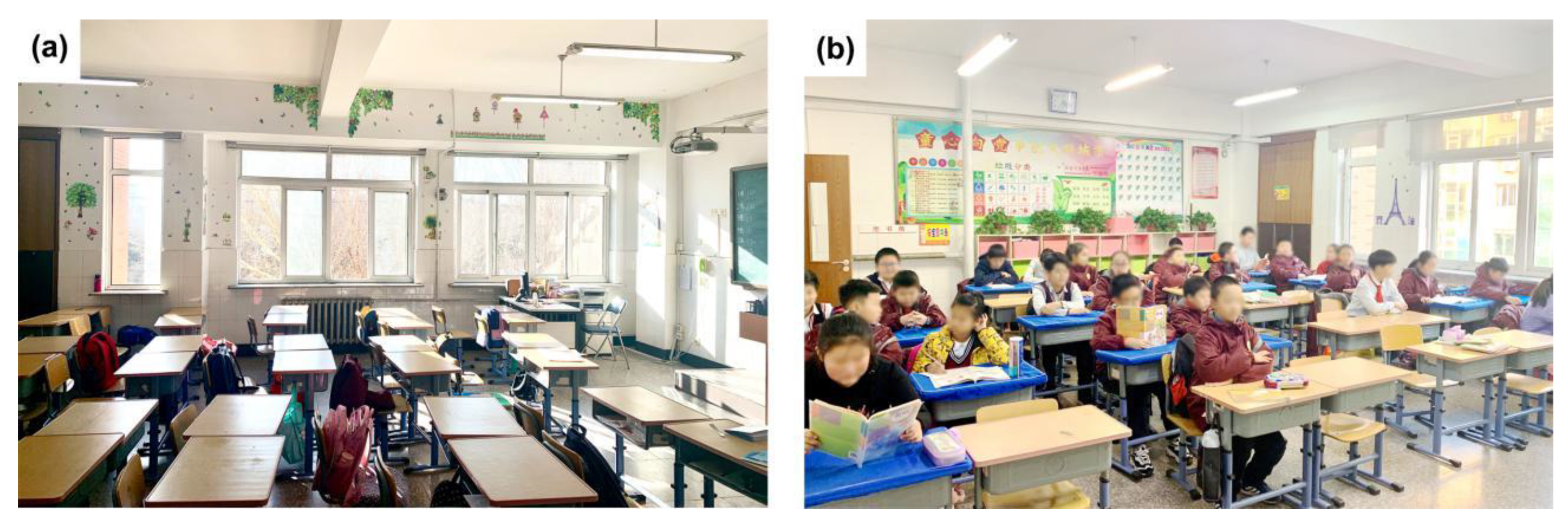

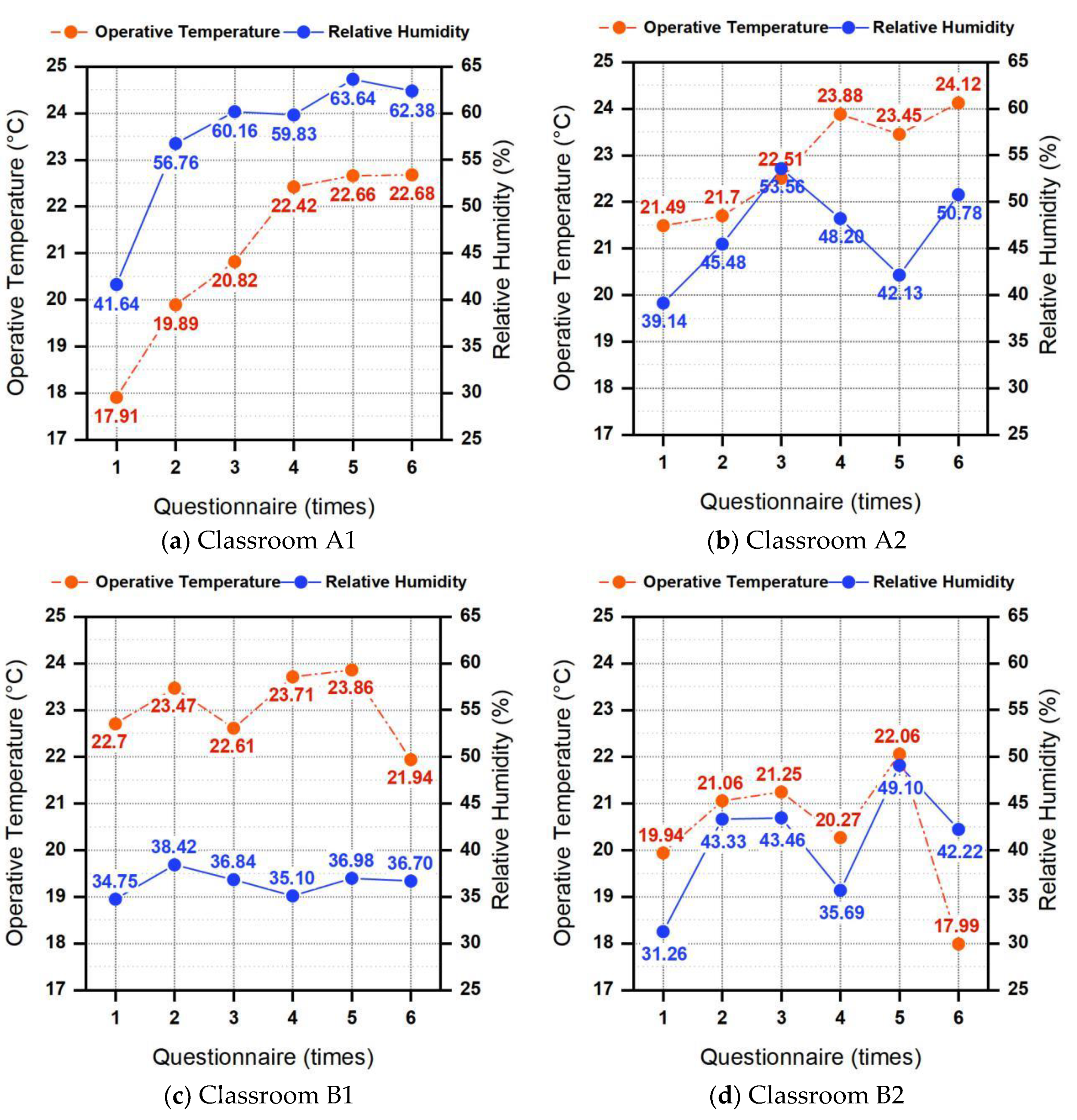

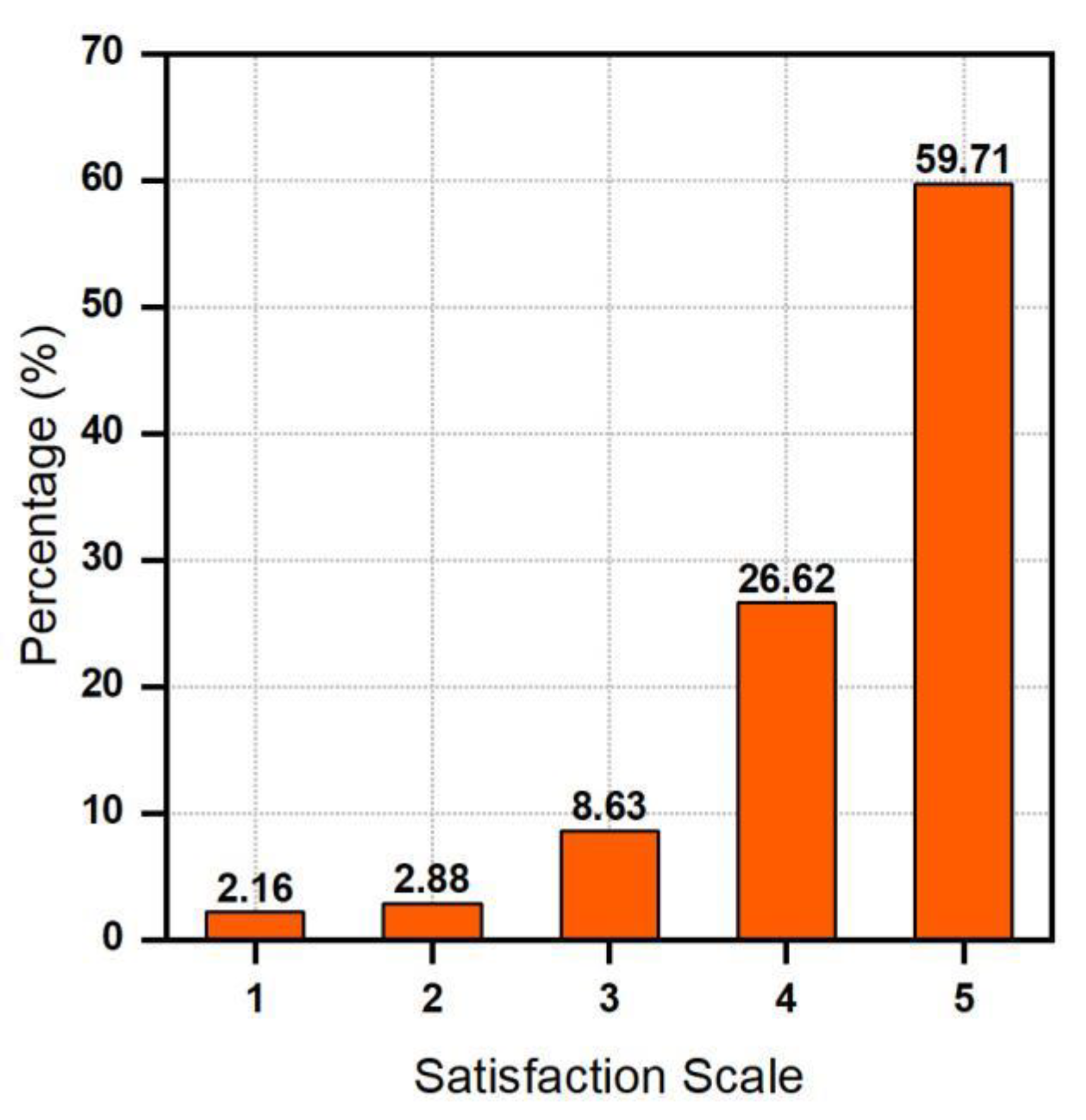
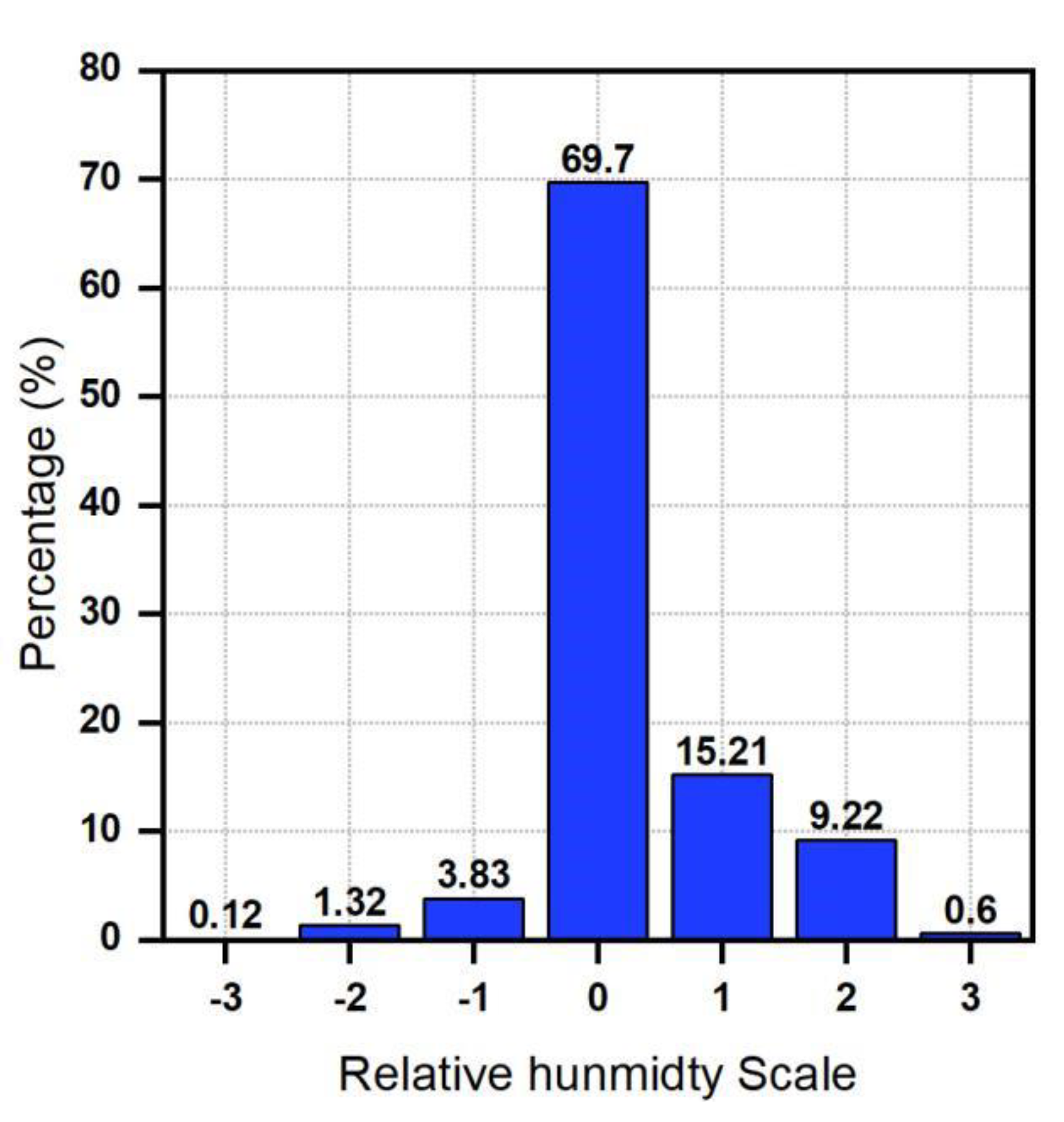

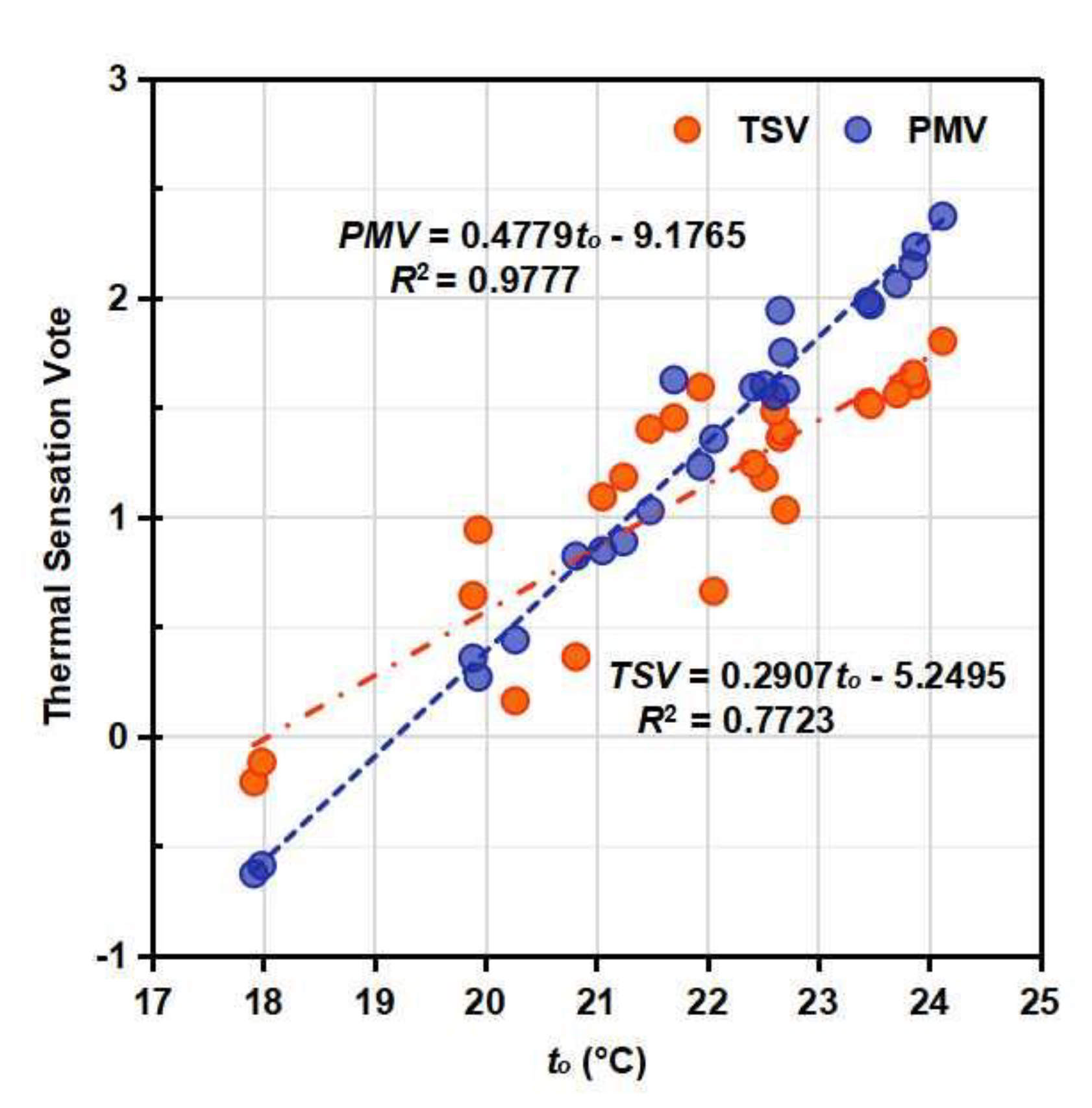
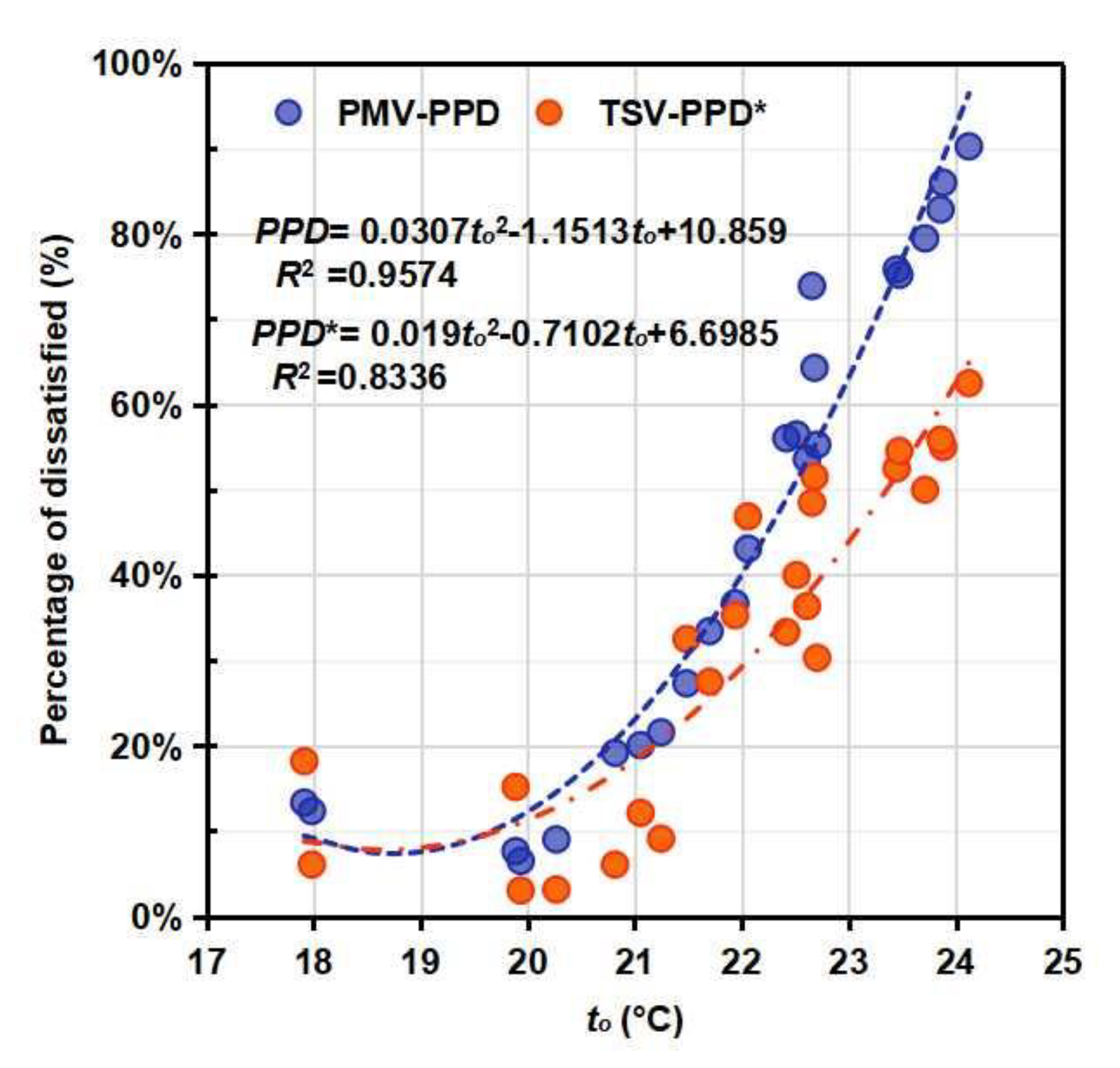
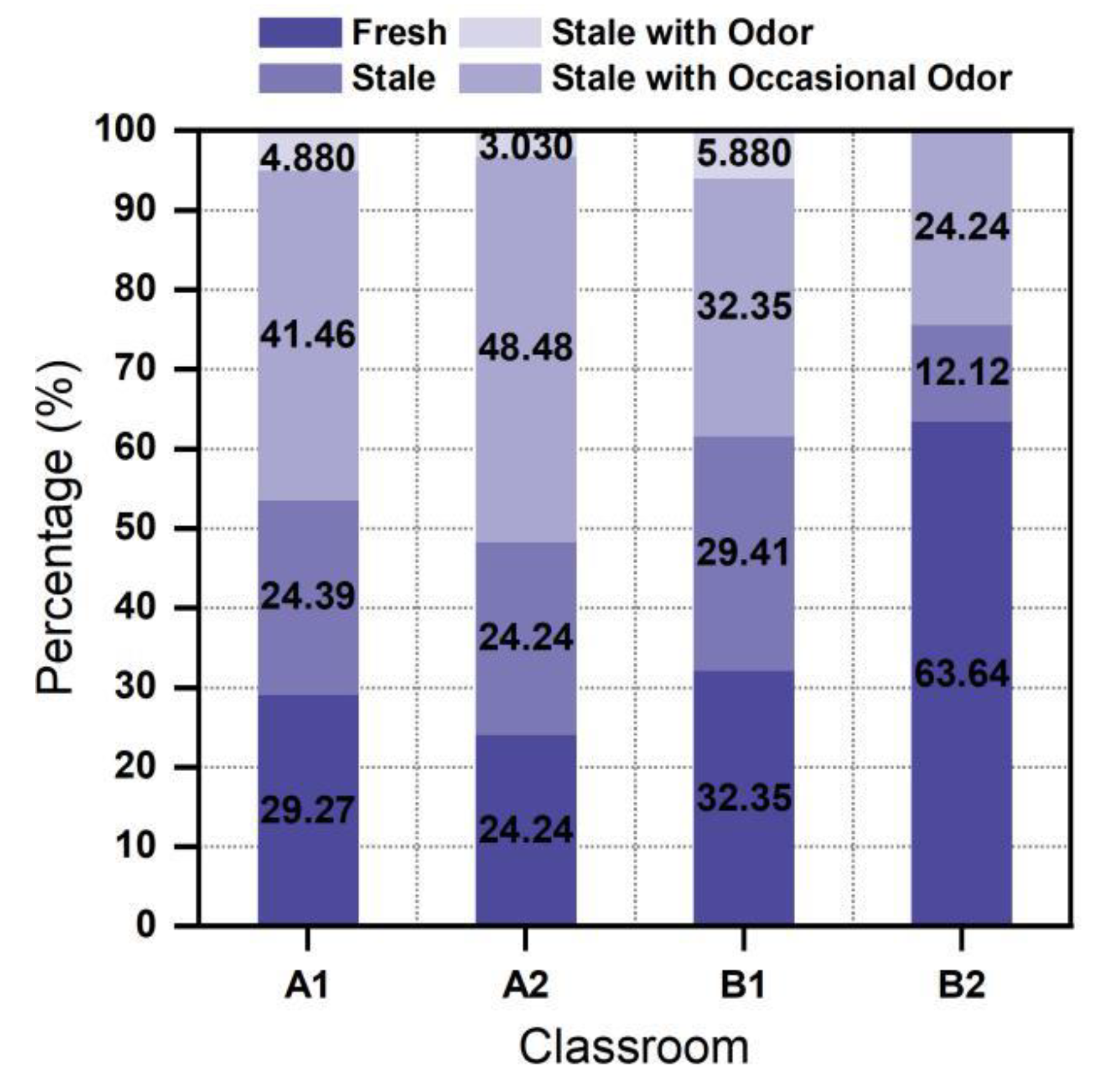
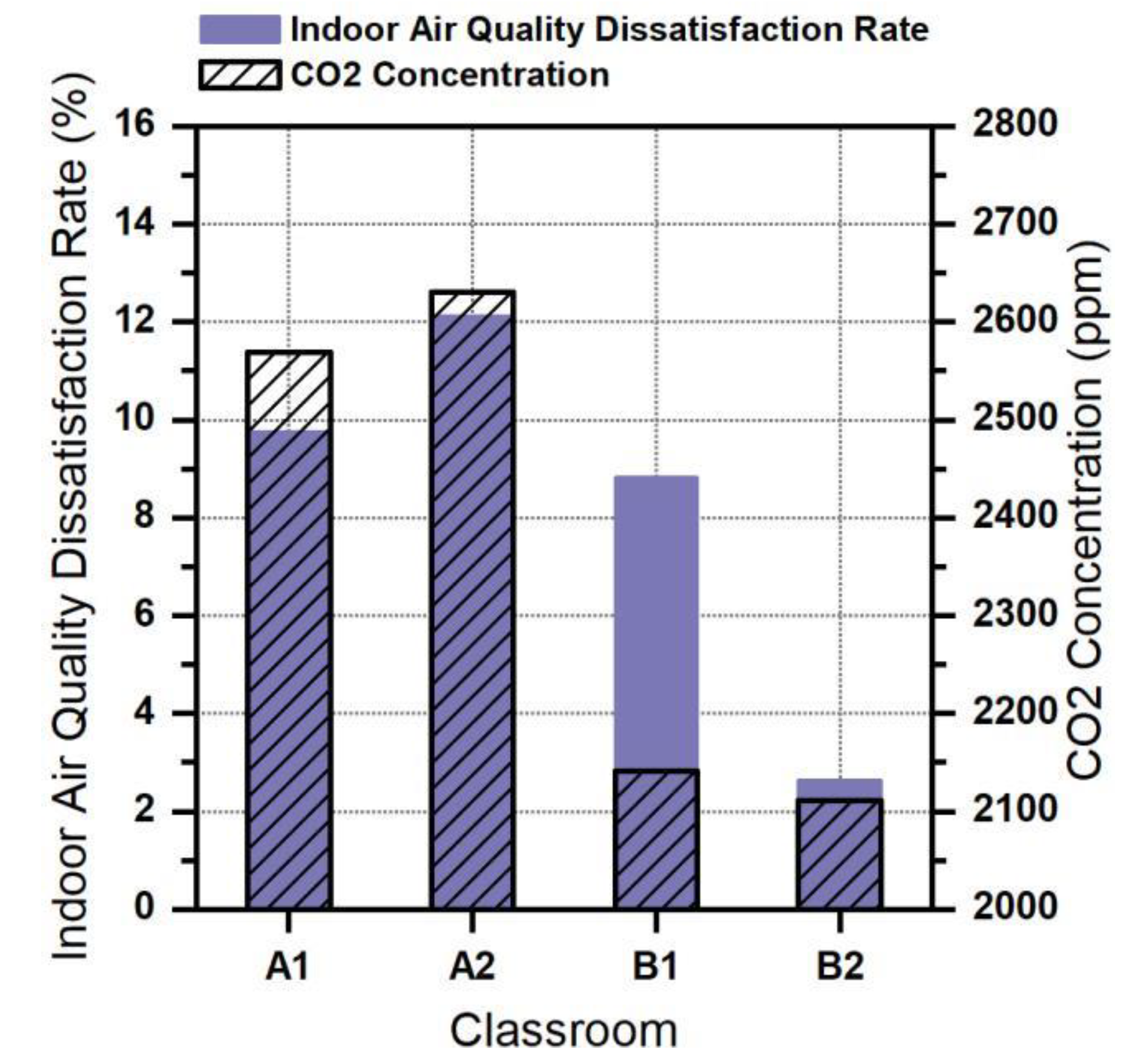
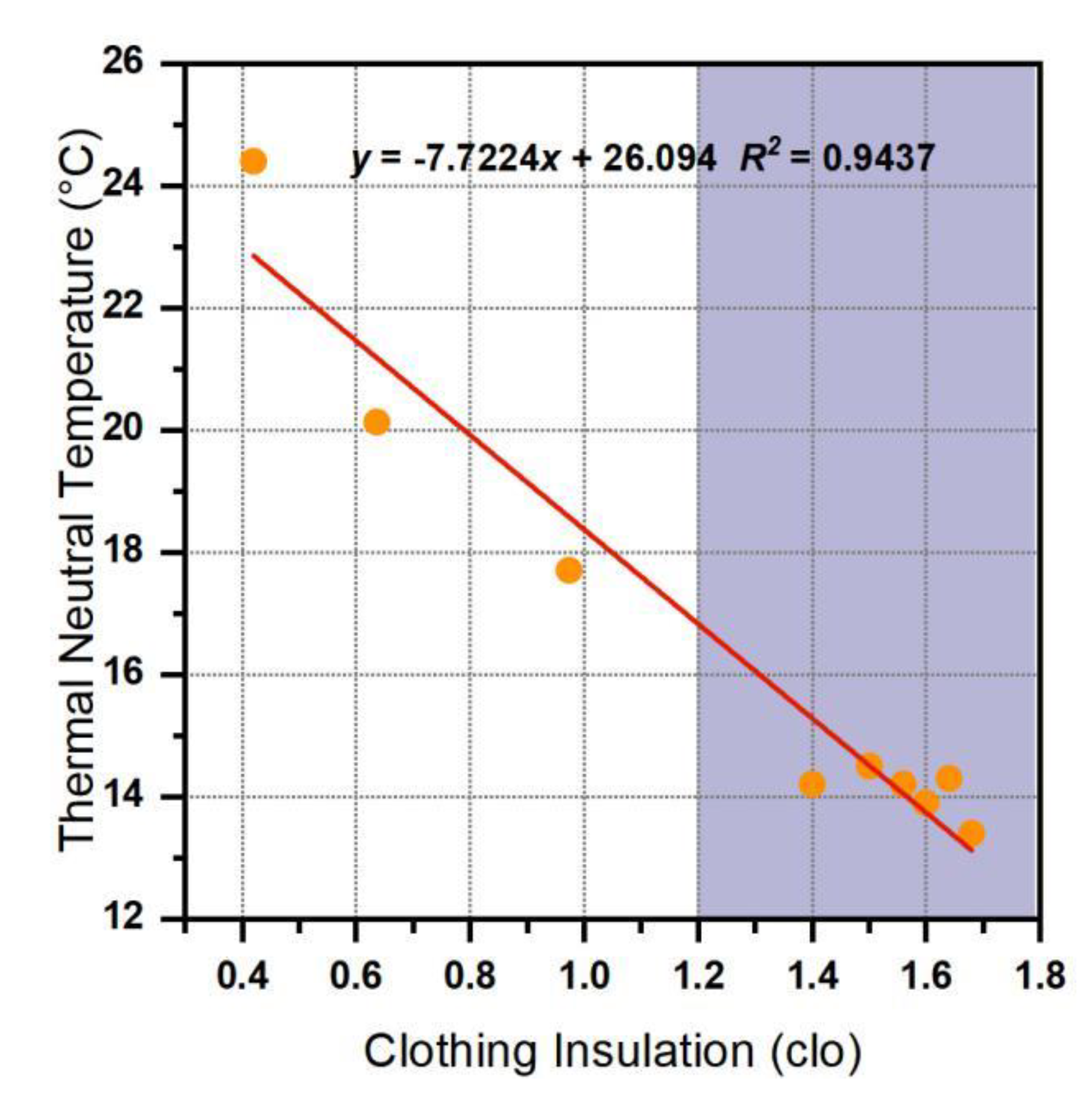
| General Information | Building A | Building B | |||||||
|---|---|---|---|---|---|---|---|---|---|
| Classroom | A1 | A2 | B1 | B2 | |||||
| Number of students | Boys | 33 | 18 | 41 | 19 | 34 | 17 | 33 | 17 |
| Girls | 15 | 22 | 17 | 16 | |||||
| Staff density (seat/m2) | 1.51 | 1.21 | 1.63 | 1.68 | |||||
| Student age(y) | 10–11 | 9–10 | 10–11 | 9–11 | |||||
| Size (m) L *W *H | 8.6 * 5.8 * 3.2 | 8.7 * 6.4 * 3.2 | |||||||
| Door (m) W *H *number | 2.1 * 0.9 * 2 | 2.1 * 0.9 * 2 | |||||||
| Exterior window (m) W *H *number | 1.7 * 2.0 * 3 | 2.4 * 2.0 * 3 | |||||||
| Interior window(m)W *H *number | 1.5 * 0.9 * 1 | 1.5 * 0.9 * 1 | |||||||
| Insulation type | No | External wall insulation | |||||||
| Ventilation type | Natural ventilation | Natural ventilation | |||||||
| Ventilation installation | No | No | |||||||
| Heating system | Electric radiant heating | Electric radiant heating | |||||||
| Floor | 4th | 4th | 4th | 4th | |||||
| Orientation | East | West | South | North | |||||
| Model | Photo | Parameter | Range | Accuracy |
|---|---|---|---|---|
| RR002 |  | ta (°C) | −40–85 °C | ± 0.6 °C |
| RH (%) | 0–100% | ±3% | ||
| HOBO MX1102 CO2 |  | ta (°C) | 0–50 °C | ±0.21 °C |
| RH (%) | 1–99% | ±0.01% | ||
| CO2 (ppm) | 0–5000 ppm | ±50 ppm | ||
| JT2020-1 |  | ta (°C) | −20–120 °C | ±3% |
| RH (%) | 10–95% RH | ±3% | ||
| tg (°C) | 0–50 °C | ±0.5 °C | ||
| va (m/s) | 0–5 m/s | ±0.03 m/s |
| 1. | How do you feel about the temperature in the classroom? | ||||||||||||
| □Very hot (3) | □Hot (2) | □Warm (1) | □OK (0) | □Cool (−1) | □Cold (−2) | □Very cold (−3) | |||||||
| 2. | How do you feel about thehumidityin the classroom? | ||||||||||||
| □Very dry (3) | □Dry (2) | □Somewhat dry (1) | □OK (0) | □Little humid (−1) | □Humid (−2) | □Very humid (−3) | |||||||
| 3. | Are you satisfied with the temperature in the classroom? | ||||||||||||
| □Very Satisfied (5) | □Satisfied (4) | □Neutral (3) | □Dissatisfied (2) | □Very Dissatisfied (1) | |||||||||
| 4. | Are you satisfied with the humidity in the classroom? | ||||||||||||
| □Very Satisfied (5) | □Satisfied (4) | □Neutral (3) | □Dissatisfied (2) | □Very Dissatisfied (1) | |||||||||
| 5. | How do you feel about the air freshness of your classroom at this moment? | ||||||||||||
| □Fresh | □Stale | □Stale with Occasional Odor | □Stale with Odor | ||||||||||
| 6. | How do you perceive the indoor air quality in the classroom? | ||||||||||||
| □Very Satisfied (5) | □Satisfied (4) | □Neutral (3) | □Dissatisfied (2) | □Very Dissatisfied (1) | |||||||||
| Site | Parameters | Maximum | Minimum | Average | St. Deviation |
|---|---|---|---|---|---|
| Outdoor | ta (°C) | 3 | −21 | −5.9 | 6.5 |
| RH (%) | 98 | 44 | 77.1 | 13.8 | |
| Indoor | top (°C) | 24.29 | 17.06 | 21.77 | 1.53 |
| RH (%) | 64.47 | 27.26 | 44.42 | 8.88 | |
| va (m/s) | 0.25 | 0 | 0.07 | 0.03 | |
| CO2 (ppm) | 5000 | 677 | 2451 | 1007 |
| Researcher | Location | Occupant | Clothing Insulation (clo) | Predictive Model (Climate) | Neutral Temperature (°C) | Comfort Range (°C) |
|---|---|---|---|---|---|---|
| Wang et al. 2014 [38] | Harbin | College students | 1.04 | TSV = 0.24top−5.43 | 22.6 | 22.0–25.0 |
| Wang et al. 2016 [39] | Harbin | College students | 1.01 | TSV = 0.16ta−2.97 | 18.0 | 16.0–22.4 |
| Yao et al. 2010 [40] | Chongqing | College students | 1.42 | TSV = 0.14ta−3.06 | 22.8 | 16.0–30.0 |
| Li et al. 2014 [41] | Beijing | College students | 1.15 | TSV = 0.17top−3.93 | 22.9 | 19.9–25.8 |
| Cao et al. 2011 [42] | Hunan | College students | 1.30 | TSV = 0.07ET*−1.70 | 20.7 | 24.1–29.7 |
| Wang et al. 2017 [43] | Shaanxi, Gansu, Qinghai | Primary students | 1.56 (Shaanxi) 1.64 (Gansu) 1.68 (Qinghai) | MTS = 0.18top−2.569 (Shaanxi) MTS = 0.13top−1.74; (Gansu) MTS = 0.16top−2.88; (Qinghai) | 14.2 (Shaanxi) 14.3 (Gansu) 13.4 (Qinghai) | 12.7–16.9 11.9–17.1 15.8–18.7 |
| Jiang et al. 2020 [12] | Shaanxi, Gansu, Qinghai | Primary students | 1.4 1.6 | TSV = 0.18top−2.56 TSV = 0.14top−1.95 | 14.2 13.9 | 12.6–16.9 14.8–17.7 |
| Our research | Shenyang | Primary students | 1.2 | TSV = 0.2907top−5.2495 | 18.05 | 16.0–21.4 |
Publisher’s Note: MDPI stays neutral with regard to jurisdictional claims in published maps and institutional affiliations. |
© 2020 by the authors. Licensee MDPI, Basel, Switzerland. This article is an open access article distributed under the terms and conditions of the Creative Commons Attribution (CC BY) license (http://creativecommons.org/licenses/by/4.0/).
Share and Cite
Ma, F.; Zhan, C.; Xu, X.; Li, G. Winter Thermal Comfort and Perceived Air Quality: A Case Study of Primary Schools in Severe Cold Regions in China. Energies 2020, 13, 5958. https://doi.org/10.3390/en13225958
Ma F, Zhan C, Xu X, Li G. Winter Thermal Comfort and Perceived Air Quality: A Case Study of Primary Schools in Severe Cold Regions in China. Energies. 2020; 13(22):5958. https://doi.org/10.3390/en13225958
Chicago/Turabian StyleMa, Fusheng, Changhong Zhan, Xiaoyang Xu, and Guanghao Li. 2020. "Winter Thermal Comfort and Perceived Air Quality: A Case Study of Primary Schools in Severe Cold Regions in China" Energies 13, no. 22: 5958. https://doi.org/10.3390/en13225958
APA StyleMa, F., Zhan, C., Xu, X., & Li, G. (2020). Winter Thermal Comfort and Perceived Air Quality: A Case Study of Primary Schools in Severe Cold Regions in China. Energies, 13(22), 5958. https://doi.org/10.3390/en13225958





